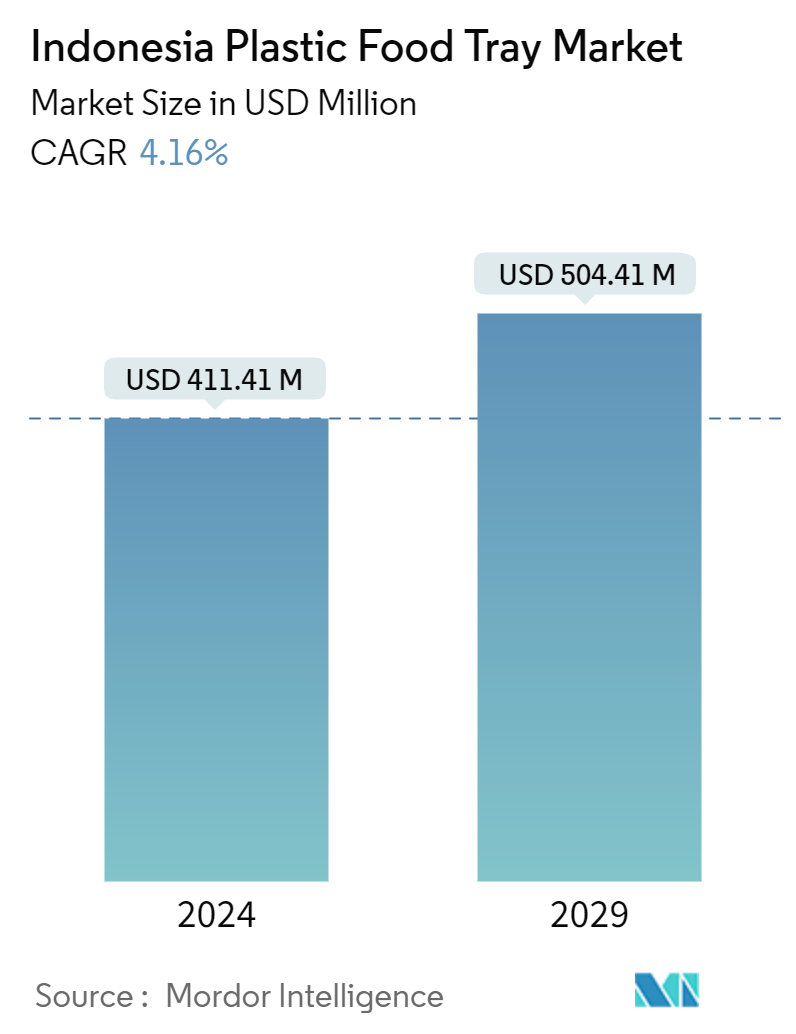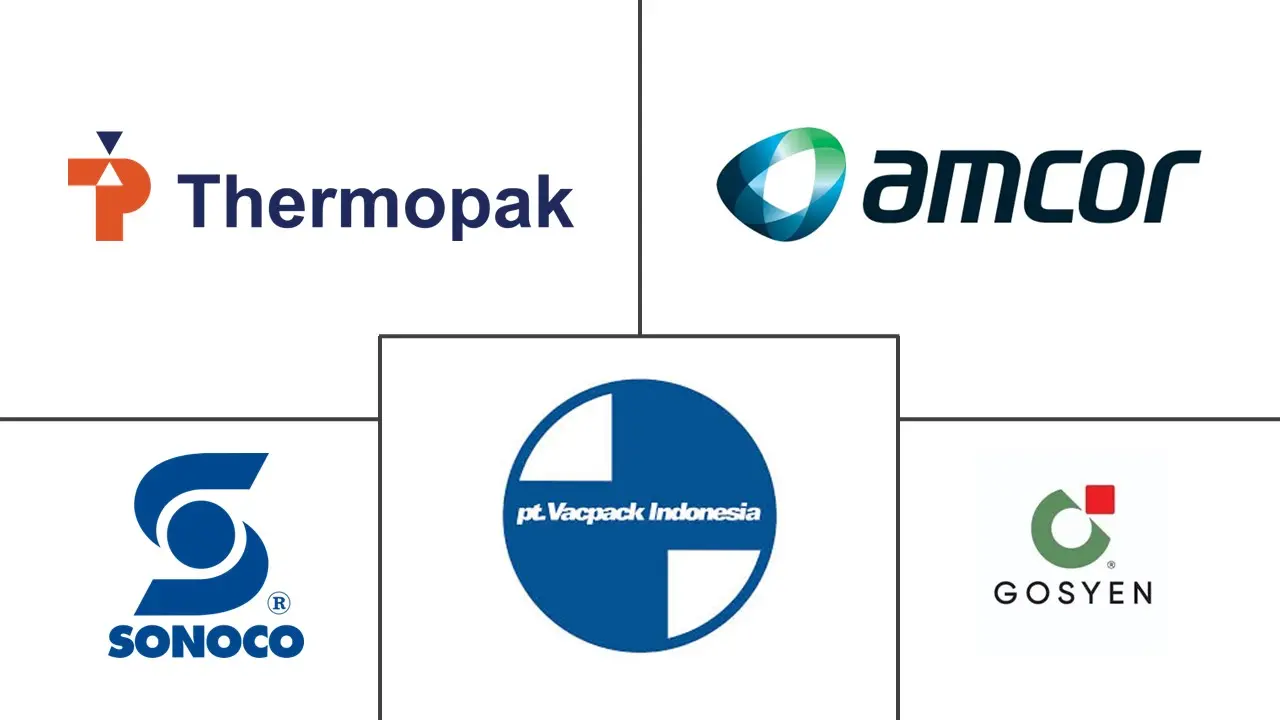Market Size of Indonesia Plastic Food Tray Industry

| Study Period | 2019 - 2029 |
| Base Year For Estimation | 2023 |
| Market Size (2024) | USD 411.41 Million |
| Market Size (2029) | USD 504.41 Million |
| CAGR (2024 - 2029) | 4.16 % |
| Market Concentration | Low |
Major Players
*Disclaimer: Major Players sorted in no particular order |
Indonesia Plastic Food Tray Market Analysis
The Indonesia Plastic Food Tray Market size is estimated at USD 411.41 million in 2024, and is expected to reach USD 504.41 million by 2029, growing at a CAGR of 4.16% during the forecast period (2024-2029).
- A growing number of restaurants, convenience stores, caterers, and other food suppliers, including online meal delivery services, have found benefits when they move from conventional paperboard, styrofoam, and aluminum material trays to plastic trays. Ready-made meals are becoming a standard solution in Indonesia for contemporary individuals because of the country's socioeconomic progress and changing lifestyles, one of the primary factors driving the market for plastic meal trays.
- The market for food trays is anticipated to register growth in Indonesia due to rising packaged food consumption. Due to a shift in customer attention toward processed and specialty foods, the consumption of plastic food trays is expected to be significant in the market. The sharp rise in demand for moisture-proof and spill-proof packaging options is responsible for the rapid growth in demand for plastic food trays. According to the Global Organic Trade Association, in 2023, the consumption value of organic packaged food in Indonesia amounted to around USD 16.7 million. The value is forecast to increase to around USD 19 million by 2025.
- Many millennials in Indonesia travel, and the search for convenient options has significantly increased the number of individuals dining out. These fast-paced trends offer many opportunities for hospitality and new developments in the country. Plastic packaging also offers benefits in enhancing business brand identity as well as strengthening visual marketing. Food trays are versatile and attractive to promote the brand and drive more sales. Digitally printed trays can enhance a brand's identity in many ways.
- With a population of 275.7 million, the fourth-largest in the world, a significant growth of the middle-income group, and a steady upward trend of expenditure per capita, Indonesia's food and beverage (F&B) industry continues to be one of the strongest businesses in the country. This trend is expected to continue in 2024. According to Statistics Indonesia, in 2023, the gross domestic product growth rate for the food and beverage manufacturing industry in Indonesia was recorded at around 4.47%.
- As of July 2023, the government provided competency-building training to 300 human resources and 200 businesses within the F&B industry. By the end of this year, the government intends to enable at least 80 F&B business owners to receive competency certificates to hasten the transition to Industry 4.0 – as is in line with the Indonesian government's Making Indonesia 4.0 Road Map. By 2024, the government plans to have 400 F&B players ready to self-evaluate the readiness of their businesses to be included in the Indonesia Industry 4.0 Readiness Index (INDI 4.0).
- Consumers in the country visit cafes and quick-service restaurants as these outlets offer affordable and convenient ready-to-eat food, thereby driving the packaging industry. Efforts by business operators to constantly improve and enhance their menus also play an essential role in attracting consumers. This channel is dominated by American and local cuisines in the country. QSR outlets are popular, offering chicken, burgers, pizza, and other food items with a local twist. In addition, in June 2024, Pizza Hut Indonesia, a pioneer of pizza companies in Indonesia, celebrated its 40th anniversary with special menus and promos to mark this significant milestone. Since its establishment, Pizza Hut Indonesia expanded to over 600 restaurants across 36 provinces. This growth reflects Pizza Hut Indonesia's commitment to providing customers with a memorable dining experience.
- In addition to these factors, the Indonesian government has implemented regulations to manage plastic waste, notably by placing restrictions on single-use plastics. These initiatives are likely to spur innovation within the plastic food trays market, prompting the emergence of more sustainable alternatives. Concurrently, as consumer preferences pivot toward eco-friendly choices, businesses operating in the plastic food trays market are swiftly adapting. They are rolling out environmentally friendly options to meet this growing demand, creating a promising picture for the market nationwide.
- Moreover, the shift toward sustainable packaging material and changing consumer preferences pose challenges to the long-term growth of the plastic food trays market. Also, increasing inflation in Indonesia poses several challenges to the development of plastic food trays. Plastic food trays are typically made from petroleum-based materials. As inflation rises, so do the costs of raw materials, making production more expensive. Manufacturers either absorb these costs, which reduces their profit margins, or pass them on to consumers, potentially reducing demand.
Indonesia Plastic Food Tray Industry Segmentation
Plastic food trays are containers made from plastic materials used primarily for packaging and serving food. Depending on their intended use, they come in various shapes, sizes, and designs. They are often used in fast-food restaurants, cafeterias, and catering services to serve meals. The Indonesian plastic food trays market is segmented by resin types into PET, PVC, PP, and other resin types. The impact of macroeconomic trends on the market is also covered under the scope of the study. Furthermore, the disturbance of the factors affecting the market's evolution in the short term, such as drivers and constraints, has been covered in the study. The market sizes and forecasts are provided in terms of value (USD) for all the above segments.
| By Resin Type | |
| PET | |
| PVC | |
| PP | |
| Other Resin Types |
Indonesia Plastic Food Tray Market Size Summary
The Indonesian plastic food tray market is poised for growth, driven by the increasing demand for convenient and ready-to-eat food options. As the country experiences socioeconomic advancements and lifestyle changes, there is a notable shift from traditional packaging materials like paperboard and styrofoam to plastic trays. This transition is fueled by the rising popularity of online meal delivery services and the need for efficient packaging solutions that offer moisture-proof and spill-proof features. The market is further bolstered by the growing consumption of packaged and processed foods, with plastic trays playing a crucial role in enhancing brand visibility and consumer appeal. The versatility and attractiveness of plastic trays, coupled with advancements in digital printing, are expected to drive their adoption across various food service channels, including cafes, quick-service restaurants, and online grocery platforms.
The market landscape is characterized by the presence of key players such as Amcor PLC, Sonoco Products Company, and Thermopak Karya Indonesia, who are actively engaging in strategic initiatives like partnerships and product innovations to maintain a competitive edge. The demand for PET food trays, in particular, is on the rise due to their cost-effectiveness and favorable properties, making them a preferred choice for food packaging. However, the market also faces challenges from environmental concerns and regulatory pressures regarding plastic use, prompting a shift towards sustainable packaging solutions. As Indonesia continues to urbanize and its middle class expands, the appetite for pre-packaged and deliverable food options is expected to grow, further propelling the plastic food tray market forward.
Indonesia Plastic Food Tray Market Size - Table of Contents
-
1. MARKET INSIGHTS
-
1.1 Market Overview
-
1.2 Industry Attractiveness - Porter's Five Forces Analysis
-
1.2.1 Bargaining Power of Suppliers
-
1.2.2 Bargaining Power of Buyers
-
1.2.3 Threat of New Entrants
-
1.2.4 Threat of Substitutes
-
1.2.5 Intensity of Competitive Rivalry
-
-
1.3 Impact of Key Macroeconomic Trends on the Market
-
-
2. MARKET SEGMENTATION
-
2.1 By Resin Type
-
2.1.1 PET
-
2.1.2 PVC
-
2.1.3 PP
-
2.1.4 Other Resin Types
-
-
Indonesia Plastic Food Tray Market Size FAQs
How big is the Indonesia Plastic Food Tray Market?
The Indonesia Plastic Food Tray Market size is expected to reach USD 411.41 million in 2024 and grow at a CAGR of 4.16% to reach USD 504.41 million by 2029.
What is the current Indonesia Plastic Food Tray Market size?
In 2024, the Indonesia Plastic Food Tray Market size is expected to reach USD 411.41 million.

